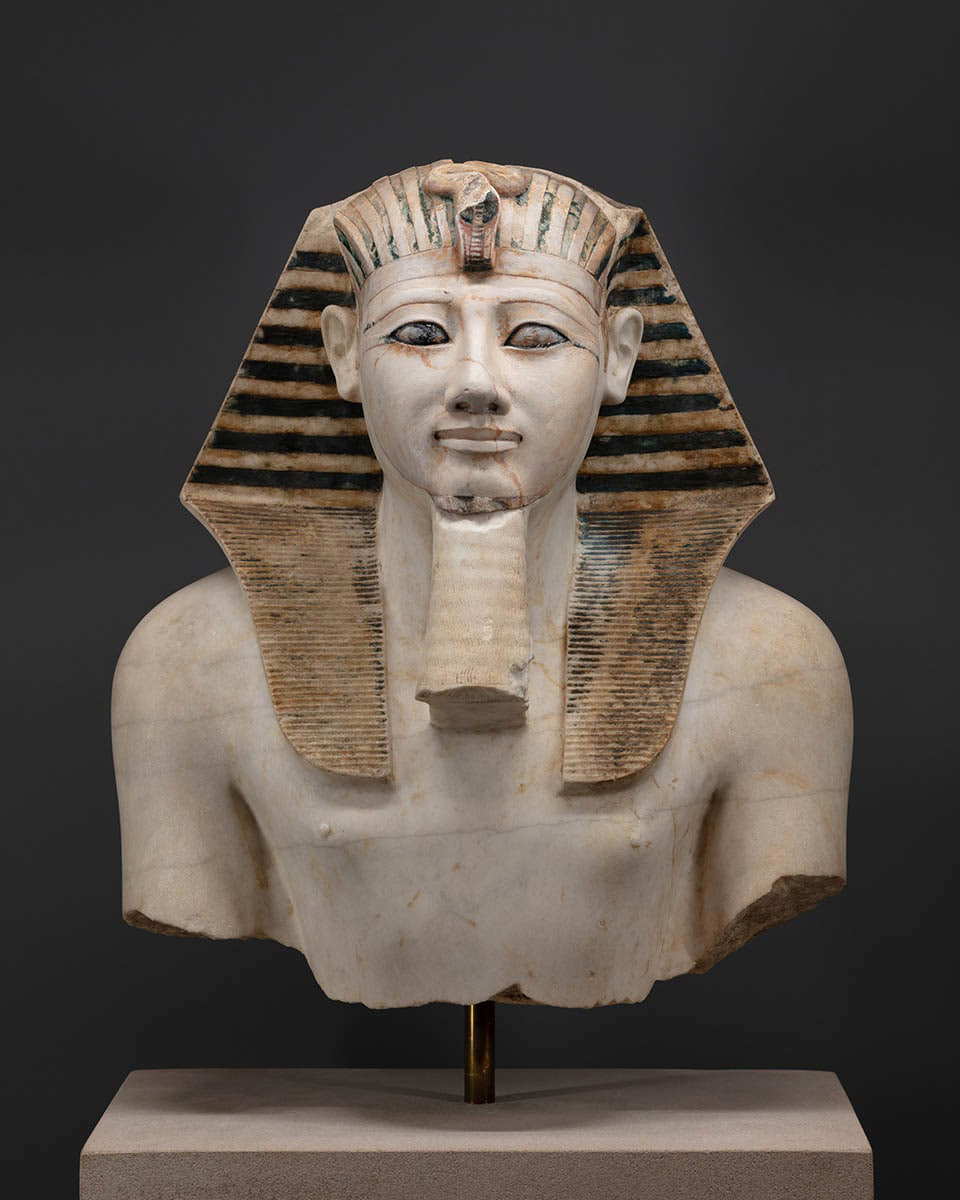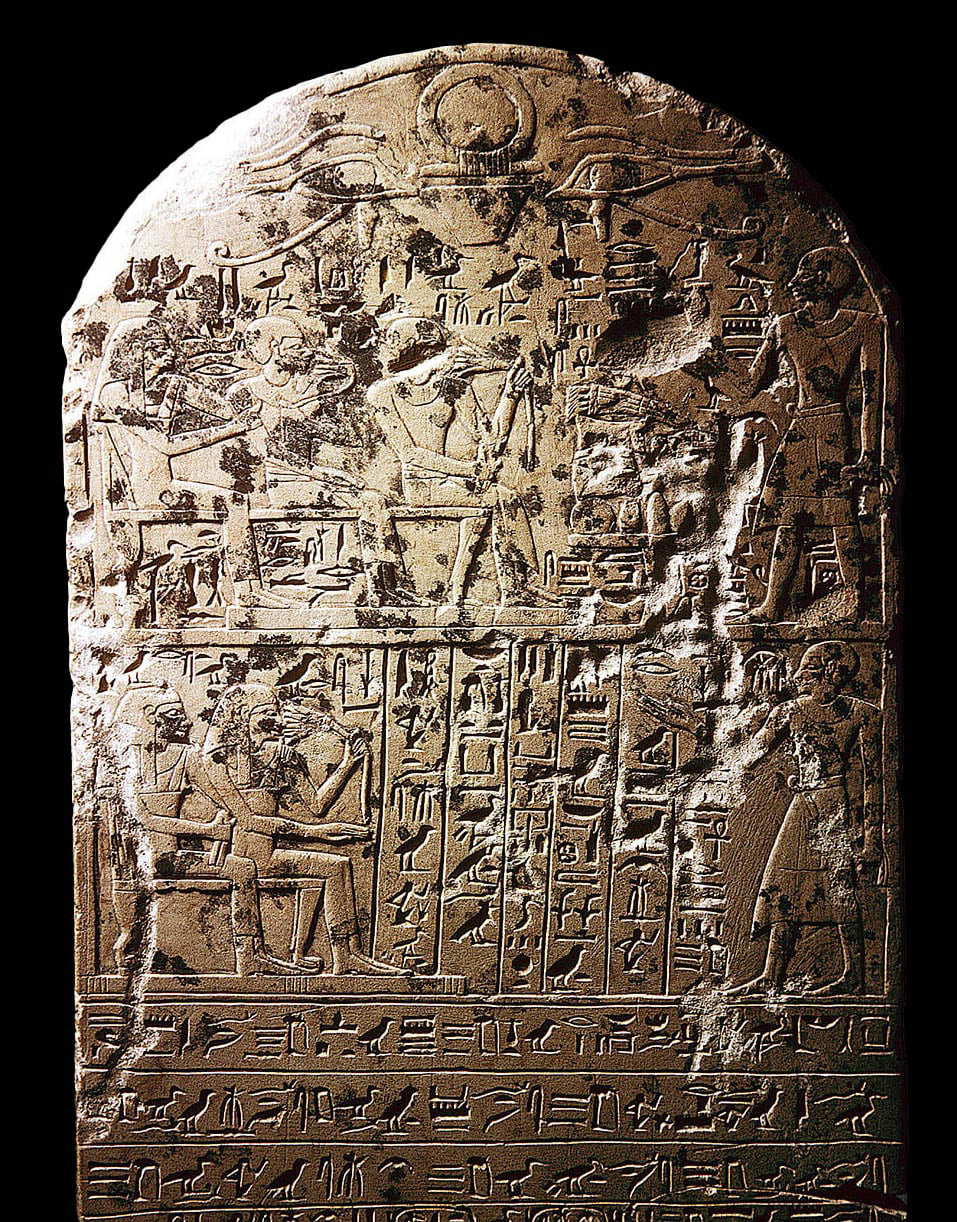Queen Hatshepsut Is an Unusual Figure in Egyptian Art Because She Was Depicted as

The 18th Dynasty of Arab republic of egypt saw the return of native rulers to the throne and the peak of Egyptian wealth and prosperity. Among those rulers was Queen Hatshepsut, the longest reigning female Pharaoh in Egyptian history, ruling from 1473-1458 B.C. When her half-brother and husband, Thutmose II, died early, her infant pace-son succeeded as Pharaoh. Though but in her early twenties, Hatshepsut took over active rule as his regent. After a few years, ousted her step-son and took over equally official Pharaoh of Egypt, enjoying a long and prosperous reign.
1. An Endeavour to Erase Hatshepsut from History Failed

Historians have struggled to slice together the details of Hatshepsut's life and reign. Ane major factor of the incertitude is the lack of bear witness, equally her name was intentionally erased from Egyptian monuments and sculptures. This was presumably the work of her step-son, Thutmose 3. For years his actions were thought to be bitter revenge against his stepmother for her usurpation of his throne, but conscientious investigation reveals more practical motives. Hatshepsut never persecuted her stepson, and, in fact, he held of import posts inside her regime and led the army. There is little evidence of whatsoever hatred between them. Even more than peculiar is the timing of the erasure. It was undertaken at the terminate of Thutmose'due south life rather than the showtime.

Additionally, mentions of Hatshepsut were non destroyed in the inner chambers of her tomb, something that would accept hindered her in the afterlife according to Egyptian tradition. An angry, jealous assault would almost certainly have also targeted those inscriptions indicating that he had no personal grudge against his stepmother. Instead, it appears that the devastation was a careful political move, intended to ensure no statement almost the rising of Thutmose III's own son, Amenhotep 2. Some historians even suggest that information technology was Amenhotep, not his begetter, who attempted to remove Hatshepsut from history.
2. She Atomic number 82 Her Own Military Campaign

Are you lot enjoying this article?
Sign upwards to our Free Weekly Newsletter
Delight check your inbox to activate your subscription
Give thanks y'all!
Upon taking command, at just xx-two years of age, Hatshepsut followed the example of her 18th dynasty predecessors and solidified her power with a short and successful armed forces campaign to the south against the Kingdom of Kush. Images and inscriptions from the tomb of Senenmut, Tiy at Seheil, and the stela of Djehuty all record the campaign, with the latter 2 being quite explicit that the campaign was led by Hatshepsut herself.
3. Hatshepsut Altered Her Image to Be More than Masculine

Early depictions of her are quite feminine, probable more realistic portrayals of her appearance. Partway into her reign, the carvings and sculptures brainstorm to take on a more masculine appearance, and she is sometimes shown in the traditional garments of male rulers of Egypt. In the later part of her life, she was depicted fully male, in male wear, and fifty-fifty with the traditional beard of Egyptian Pharaohs. This, non surprisingly, caused a slap-up bargain of defoliation for early archeologists attempting to pinpoint the timelines and identities of the Egyptian Pharaohs. To make things worse, by the cease of her reign, Hatshepsut had dropped whatever titles that were exclusively held by women in ancient Egypt, and was even using the masculine form of her name, Hatshepsu.
iv. In the Ninth Year of her Reign, She Launched a Massive Expedition to the Land of Punt

Punt, or "the Divine Land," is believed to exist located almost mod Somalia. The expedition was a major success, and the Egyptians returned home laden with fantastic and exotic items. One of the almost ambitious goals of the journey was to bring back living myrrh trees to cultivate in Egypt. Incense and myrrh were very expensive substances in the aboriginal earth every bit they grew in very express locations. Yet, many cultures, including Arab republic of egypt, required their use in religious and funerary ceremonies. Wall paintings in Hatshepsut'south funerary temple show the expedition members returning with these trees. Unfortunately, they were sick-suited to Egypt's climate and none survived, just merchandise with Punt appears to have continued throughout her reign.
5. I Theory Suggests that Hatshepsut Might Be the Biblical Queen of Sheba

An interesting theory suggests that Punt was not a region to the south of Egypt but was actually the region of Judea, and that Hatshepsut is, in fact, the legendary Biblical Queen of Sheba who met with Solomon. In his 1952 book Ages of Chaos, Immanuel Velikovsky argued that the 18th Dynasty had been incorrectly dated and actually landed about five centuries later in history. The modify in timeline resolves several long-continuing discrepancies between the histories of Egypt and Israel.
It also makes Hatshepsut and Solomon contemporaries. Velikovsky pointed to a passage in the well-known ancient Jewish historian Josephus, writing in the 1st century A.D., who explicitly states that the Queen of Sheba was "the woman who, at that time, ruled every bit queen of Egypt." Velikovsky believed that the mysterious "land of Punt" really referred to Jerusalem, and that all of the exotic items brought dorsum to Egypt could accept been constitute, at that fourth dimension, in the Jordan River Valley. Though the theory has not been widely accepted, and reliefs depicting the journeying seem far more than consequent with a southern African destination, information technology is all the same fascinating to consider.
6. She Was One of the Well-nigh Prolific Builders in Egyptian History

The previous dynasty of occupying Hyksos rulers had caused heavy devastation to Egyptian fine art and monuments. Hatshepsut restored the damages and rebuilt even bigger and greater. Her works included the restoration of the Precinct of Mut at Karnak, The structure of the Crimson Chapel at Karnak, and the structure of the Temple of Pakhet at Beni Hasan. So many statues were deputed during her reign that almost every museum in the world today that features Egyptian artifacts contains some from her era. In fact, the New York Metropolitan Museum of Art has an entire Hatshepsut room dedicated to statues from her reign. Hatshepsut also deputed numerous obelisks, including one that remains the tallest surviving aboriginal obelisk in the globe.
7. Her Greatest Architectural Cosmos Is Her Mortuary Temple Complex at Deir El-Bahri

The construction of the magnificent Mortuary Temple of Hatshepsut was overseen past her chief steward, Senenmut, and took around xv years to consummate. Although the nearby Temple of Mentuhotep Two provided some inspiration, Queen Hatshepsut's temple varies significantly in several stylistic aspects. It marks a switch in Egyptian temple pattern from the massive, geometric Onetime Kingdom way toward one intended for more agile utilize past worshippers. The temple is 3 stories tall, continued by ramps and terraces. In its mean solar day, it contained shrines, chapels, and the sanctuary of Amun-re. These were all woven together with carved reliefs, reflecting pools, and elaborate gardens of exotic plants and copse.

The mortuary temple contains 2 important, painted, depression-relief sequences, one detailing the famous expedition to Punt and the other portraying events of Queen Hatshepsut's life, carefully planned by Hatshepsut to further establish her right to dominion. In the relief, Amun asks the blessings of the other gods for the cracking and powerful Queen that is to come, and and then visits Hatshepsut'south female parent disguised as Thutmose I and conceives Hatshepsut. In another scene showing Hatshepsut's elaborate coronation, her father crowns her King, carrying the idea that it was always his intention for his girl to rule. There may exist some truth to that, as Hatshepsut had an active office in the government of both her father and brother and came to power experienced in administration. However, true or not, it forms an constructive slice of propaganda in support of Hatshepsut'southward sole right to rule.
8. She May Take Had an Thing With Her Steward

Historians today whisper rumors that Queen Hatshepsut had a lover – none other than her master steward, Senenmut. Archeologists were shocked to detect that Hatshepsut immune Senenmut to accept his own proper noun and image painted into her mortuary temple, an unprecedented honor. He was also plainly unmarried, a very odd state for a mature Egyptian man, and he and Hatshepsut were cached in a matching pair of sarcophagi.
The other clue to this comes from a piece of interesting graffiti. Near Hatshepsut's temple was an old, unfinished tomb that workers used equally a house during construction. On one of its walls is an image of a human and a pharaoh making love. The pharaoh is depicted rather androgynously, and the homo is presumed to be Senemut. Of class, this is non proof of a dearest matter but suggests that the temple workers had the aforementioned suspicions that plague historians today.
9. Finding Hatshepsut's Body Has Been a Long and Restless Attempt

In the Erstwhile and Middle Kingdoms of ancient Egypt, the king's mortuary temple normally adjoined their pyramid and tomb. Nonetheless, when archeologists excavated Hatshepsut's mortuary temple, her body was nowhere to be plant. Exploration of tomb KV20 in the Valley of Kings, believed to exist the original tomb of Thutmose I, found items associated with Hatshepsut, likewise as a canopic box inscribed to her. Historians believe that Queen Hatshepsut built an addition onto her male parent's tomb and was originally interred with him, but her trunk was later removed. Another tomb in the valley, KV60, revealed ii female mummies. One had a coffin inscribed with the title "majestic nurse," speculated to exist that of Hatshepsut's nurse, Sit-Ra. The 2nd body was thought to exist that of Hatshepsut, and CT scans of both the mummy and the canopic box found in KV20 seemed to confirm that.

The female mummy diameter sure physiological aspects that are consequent with CT scans of other royal family members. The scans also showed that the mummy was missing a molar with one broken root remaining in the jaw. Scans of the canopic box revealed an embalmed liver or spleen, intestines, and a single human molar, missing 1 root. Dr. Galal El-Beheri, an orthodontist, working on the project, concluded that the tooth fit the gap, but non all scholars are convinced.
Questions remain regarding the precision of the match and the question of the missing third root of the upper molar. Although absolute positive identification has not been made, the large collection of circumstantial evidence suggests that the mummy with the missing tooth is that of Queen Hatshepsut.
10. Queen Hatshepsut May Have Accidentally Caused Her Own Decease

The mummy believed to be Hatshepsut reveals the Queen every bit standing but over v anxiety, was overweight and had rotten at the time of her death. She had long hair of a golden colour and ruddy-painted fingernails. Modern applied science has been able to determine even more than about the neat Queen. She apparently suffered from arthritis and diabetes in her later years, as well as os cancer, which is presumed to be the crusade of her death. The cancer's crusade has even been determined. Queen Hatshepsut appears to have struggled with some kind of chronic, genetic skin disease. She covered this with a lotion, whether to disguise it or as an attempt to improve it. Unfortunately for the Queen, the lotion itself was a carcinogenic substance, which slowly penetrated and caused her fatal bone cancer.
Traveling to Arab republic of egypt? Brand sure to read our curated itinerary for History Lovers compiled by an Egyptologist living in Egypt for the terminal 20 years.
Source: https://www.thecollector.com/hatshepsut-egyptian-queen-king/
0 Response to "Queen Hatshepsut Is an Unusual Figure in Egyptian Art Because She Was Depicted as"
Post a Comment